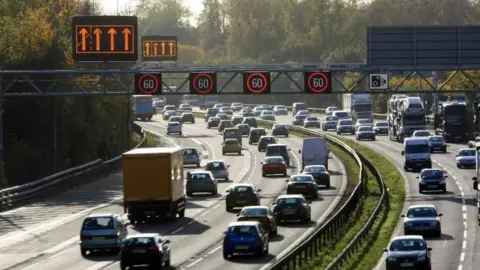M1 and M5 smart motorway refuge bays 'won't make roads safer'
 BBC
BBCThe installation of 50 new emergency areas on smart motorways "won't make roads safer", campaigners say.
Months of roadworks to install new refuges on smart motorways through the Midlands began on Tuesday.
National Highways said the work will make smart motorways safer.
Ana Borges, whose car was hit by a lorry when it broke down on the M1, said the only way to ensure drivers are safe on motorways is to reintroduce hard shoulders.
The new emergency bays are being installed along the M1 in Derbyshire, Nottinghamshire, Leicestershire and Northamptonshire and the M5 in Worcestershire.
The installations are to address safety concerns on smart motorway sections, where overhead gantries are used to control lanes and speed limits rather than have a permanent hard shoulder, National Highways said.
Each refuge will be 100m long and between 0.75 and one mile (1.2-1.6km) apart.
Mrs Borges, from Kegworth, Leicestershire, suffered spinal injuries, five broken ribs and a broken chest bone in a crash near junction 24A in Nottinghamshire in April 2023.
 PA
PAShe said: "I broke down between emergency bays.
"I remember seeing a sign saying the next emergency bay was 400 yards away, and I never reached it.
"It's not going to make the roads safer at all.
"I just don't understand why they are spending money building new bays if they can just put the hard shoulders back again.
"It doesn't make much sense at all."
 PA Media
PA MediaCampaigner Claire Mercer, whose husband Jason died on the M1 near Sheffield, said refuge areas "don't cut it".
"If your vehicle is going to break down, it's not going to do it near a refuge area; it's not going to take the nearest refuge area into consideration," she said.
"There was also a very important user of the hard shoulder - the emergency services.
"Refuge areas are not acceptable. It's not good enough, fortunately."
National Highways project sponsor Felicity Clayton said reinstating hard shoulders "could put more drivers and passengers at risk of death and serious injury".
"The hard shoulder is perceived to be a place of safety, but, in reality, one in 20 motorway fatalities happen there," she said.
"Emergency areas are safer than hard shoulders.
"All Lane Running motorways have a whole system of safety features to improve journeys and keep journeys safe."
Months of disruption
Works to create the refuge site are expected to continue into spring 2025.
Where works are being carried out, lane one will be closed with remaining lanes open with 50mph limits in force.
Between junctions 28 and 30 of the M1, work to create 18 emergency areas is due to start on 2 April, running until January 2025.
Between junctions 23a and 25 on the M1, construction of six new refuges starts from 4 April, due to be completed by the end of November.
Twenty new emergency areas between junctions 16 and 19 begin construction from 15 April, with work due to run until next March.
And on the M5, between junctions 4a and 6, the creation of 10 new areas starts on 22 April, scheduled to be complete by spring 2025.

Follow BBC East Midlands on Facebook, on X, or on Instagram. Send your story ideas to [email protected] or via WhatsApp on 0808 100 2210.
